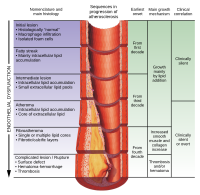
Photo from wikipedia
Abstract Lower prenatal exposure to n-3 PUFA relative to n-6 PUFA has been hypothesised to influence allergy development, but evidence remains largely inconsistent. In the Dutch Maastricht Essential Fatty Acid… Click to show full abstract
Abstract Lower prenatal exposure to n-3 PUFA relative to n-6 PUFA has been hypothesised to influence allergy development, but evidence remains largely inconsistent. In the Dutch Maastricht Essential Fatty Acid Birth (MEFAB) (n 293) and Greek RHEA Mother–Child (n 213) cohorts, we investigated whether cord blood phospholipid PUFA concentrations are associated with symptoms of wheeze, asthma, rhinitis and eczema at the age of 6–7 years. Information on allergy-related phenotypes was collected using validated questionnaires. We estimated relative risks (RR) and 95 % CI for associations of PUFA with child outcomes using multivariable generalised linear regression models. In pooled analyses, higher concentration of the n-3 long-chain EPA and DHA and a higher total n-3:n-6 PUFA ratio were associated with lower risk of current wheeze (RR 0·61; 95 % CI 0·45, 0·82 per sd increase in EPA+DHA and 0·54; 95 % CI 0·39, 0·75 per unit increase in the n-3:n-6 ratio) and reduced asthma risk (RR 0·50; 95 % CI 0·31, 0·79 for EPA+DHA and 0·43; 95 % CI 0·26, 0·70 for the n-3:n-6 ratio). No associations were observed for other allergy-related phenotypes. The results were similar across cohorts. In conclusion, higher EPA and DHA concentrations and a higher n-3:n-6 fatty acid ratio at birth were associated with lower risk of child wheeze and asthma. Our findings suggest that dietary interventions resulting in a marked increase in the n-3:n-6 PUFA ratio, and mainly in n-3 long-chain PUFA intake in late gestation, may reduce the risk of asthma symptoms in mid-childhood.
Journal Title: British Journal of Nutrition
Year Published: 2018
Link to full text (if available)
Share on Social Media: Sign Up to like & get
recommendations!